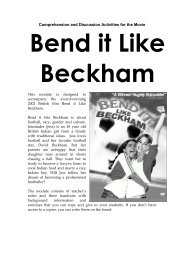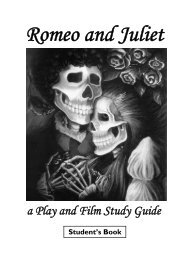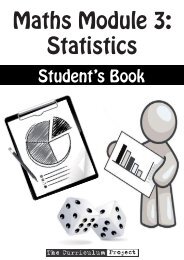Download - The Curriculum Project
Download - The Curriculum Project
Download - The Curriculum Project
You also want an ePaper? Increase the reach of your titles
YUMPU automatically turns print PDFs into web optimized ePapers that Google loves.
7. Writing: CVsThis section looks at CVs – <strong>Curriculum</strong> Vitaes [vee-tayz] – the formal document people need to write in orderto apply for many jobs, training courses and scholarships. It covers both content and format of CVs.7.1 What’s in a CV?A. Discuss CVs (a list of a person’s education, work experience, and other achievements, used to applyfor jobs and sometimes training courses). Students read Yan Naing’s CV. Clarify anything they don’tunderstand. Individually, or in pairs or groups, students answer the questions.Answers:1. To summarise information about you, so that people can decide if you are the right person for a jobor course.2. <strong>The</strong> most important things on a CV are your contact information, education, qualifications andwork experience. It’s a good idea to add any interests or special skills you have, including languageskills, and any awards or publications you have. See the Language/Culture Notes for advice onbiographical details.3. Not a lot.4. High school graduation certificate, BSc (Bachelor ofScience) degree, a two-week teacher training certificate.5. 20006. Trainee teacherLanguage/Culture NotesIn some countries it is inappropriateto put biographical information suchas age/date of birth, marital status,ethnicity or religion in a CV. If you areapplying to a Western organisation,you don’t need to include these details.B. Students look at the information about Aung Mon on page 140,and fill in the information for him. Some information is notavailable, so students should use their own ideas.Answers:1. Rangoon (students can think of an address, phone number and/or email)2. High school certificate (probably 1996), 1 year of a BA in Law (1996)3. 1999-2001: Head teacher, 1998-1999: Teacher, 1998: Gardener, 1997-1998: Factory worker,1996-1997: Dishwasher4. Management, teaching, some knowledge of the law5. Burmese, English, MonC. Students read Nang Si’s and Zainab’s CVs. Clarify anything they don’t understand.Answers:Nang Si’s CV• <strong>The</strong>re are no contact details (address, phone number or email address).• <strong>The</strong>re is no logical order to headings. Usually we put the more important categories (education andexperience) first, and optional extras (interests) towards the end.• When including details of work experience, such as job responsibilities, we don’t usually write incomplete sentences – you don’t need to start with ‘I’. It is also a good idea to make these phrasesthe same style: all starting with a past tense verb (i.e. ‘helped’, ‘hired’, ‘checked’, etc.), or apresent tense verb, like in Zainab’s CV, or all using gerunds (‘writing’, ‘hiring’, etc.).Zainab’s CV is much better, because it lists all the information in logical order. It is clear and easy toread, and has all the essential contact information.D. Students answer the questions.Answers:1. No (see C above).2. We usually use reverse chronological order, i.e. the most recent goes at the top, then the earlier onesafter that in reverse chronological order (most recent to earliest).3. Some people include a photo, or biographical information (see the Language/Culture Notes).E. Students write their own CVs. Before they start, they should write out all the CV categories and notethe information for each category. Get them to think about the details of any jobs they have done. Howwill they phrase them? Point out to the students that even if you don’t have much education or workexperience that would look important on a CV, it doesn’t mean you can’t write a good CV. It is importantto present whatever information you have clearly and in logical order. Students should follow the formatof Zainab’s CV.Module 917



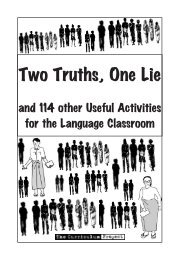
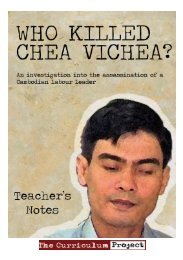

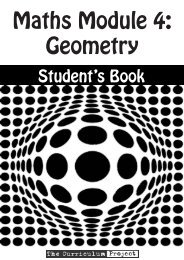

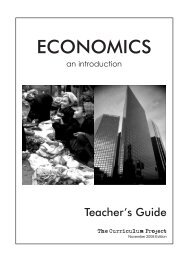
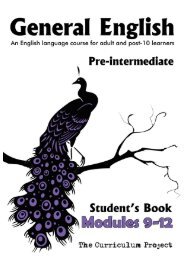

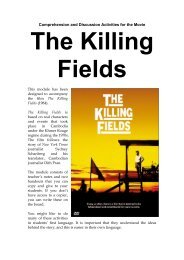
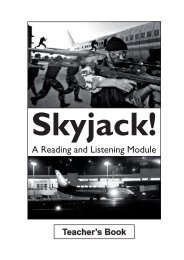
![[Eng] Nov 2012 DRAFT - The Curriculum Project](https://img.yumpu.com/45590859/1/184x260/eng-nov-2012-draft-the-curriculum-project.jpg?quality=85)
